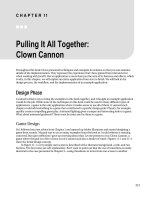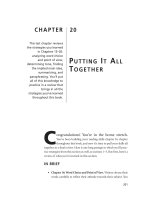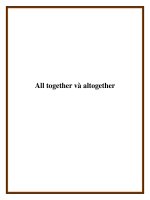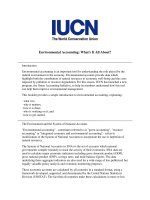Putting It All Together
Bạn đang xem bản rút gọn của tài liệu. Xem và tải ngay bản đầy đủ của tài liệu tại đây (155.56 KB, 37 trang )
201
CHAPTER
20
P
UTTING
I
T
A
LL
T
OGETHER
This last chapter reviews
the strategies you learned
in Chapters 15–20:
analyzing word choice
and point of view,
determining tone, finding
the implied main idea,
summarizing, and
paraphrasing. You’ll put
all of this knowledge to
practice in a review that
brings in all the
strategies you’ve learned
throughout this book.
C
ongratulations! You’re in the home stretch.
You’ve been building your reading skills chapter by chapter
throughout this book, and now it’s time to pull your skills all
together in a final review. Here is one long passage in which you’ll prac-
tice strategies from this section as well as sections 1–3. But first, here’s a
review of what you’ve learned in this section.
IN BRIEF
•
Chapter 16: Word Choice and Point of View. Writers choose their
words carefully to reflect their attitude towards their subject. You
READ BETTER
,
REMEMBER MORE
202
learned how to look for clues in word choice and point of view to
make inferences about the writer’s attitude.
•
Chapter 17: Determining Tone. You learned how word choice and
point of view work together to create tone. Tone is the mood or
attitude conveyed by words or speech. You practiced recognizing a
variety of different tones of voice and made observations to
support your inferences and boost your retention.
•
Chapter 18: Finding an Implied Main Idea. You learned how to
work like a detective and find clues to determine the main idea
when the writer doesn’t provide clear topic sentences. You looked
at word choice, point of view, and tone to see what main idea all of
the other sentences in the passage added up to.
•
Chapter 19: Putting It in Your Own Words. You practiced two
powerful reading strategies: summarizing and paraphrasing. You
learned how to “process” what you read and “translate” those ideas
into your own words. When you summarized, you focused on the
main idea and key support and put them into your own words.
When you paraphrased, you rewrote sentences idea by idea.
If any of these terms or strategies sound unfamiliar to you, STOP. Take
a few minutes to review the chapter or concept that is unclear.
P
RACTICE
Here’s one long passage about taxes. Pre-read first, and then answer the
pre-reading question. Then, read the passage carefully. Keep in mind the
following points, which are essential parts of this exercise:
•
You may use your vocabulary list, but not a dictionary.
•
As you read, write your questions and reactions in the margin.
•
Highlight or underline the text as you read.
Pre-Reading Question:
1
. Based on your pre-reading, what do you expect to learn from this
passage? On a separate sheet of paper, write several questions that you
expect the passage to answer.
PUTTING IT ALL TOGETHER
203
Change the Tax System
Every year, April 15th comes around like a recurring night-
mare. Citizens brace themselves for the agony of complicated
forms and hours of gathering numbers and receipts to figure
out how much more of their hard-earned money they’ll be
forced to give to Uncle Sam. It’s a task and a system that cit-
izens loathe, and it’s time for a serious restructuring of the
U.S. tax system.
Citizens are currently being taxed for working hard and
saving money—two activities we should encourage. Instead,
citizens should be taxed for the “bad” things that they do.
That is, they should be taxed on the things that deplete our
natural resources, pollute our environment, and create
waste. These taxes fall into three categories: taxes on energy
consumption, taxes on health deterrents, and taxes on luxu-
ry. At the same time that these taxes are increased, taxes on
earnings and savings should be reduced proportionately.
Taxes on Energy Consumption
The gasoline that we put in our cars pollutes the air and
drains our natural resources. Traffic jams clog our streets and
create noise pollution. A higher tax on gasoline, on oil, and
on cars and car parts would encourage people to conserve
gas, to carpool, to use public transportation, and to walk or
ride bicycles when possible. Citizens would then benefit from
cleaner air and healthier bodies.
Electricity and other forms of energy should also be taxed
at higher rates to help us conserve our natural resources.
Increased taxes on electricity would encourage people to
turn off lights and appliances when not in use. In addition, it
would discourage people from buying gadgets they don’t
need, like salad shooters and electronic calendars. Citizens
would hang their clothes to dry more often instead of run-
ning the dryer, would use a regular toothbrush instead of an
electric one, and would cook their food in ovens rather than
the microwave (a much healthier choice).
READ BETTER
,
REMEMBER MORE
204
Taxes on Health Deterrents
Cigarettes and alcohol are already taxed—but they should
be taxed more. The tremendous burden in health care costs
created by these habits alone should warrant higher taxes on
these addictive substances. Higher taxes on cigarettes and
alcohol will help reduce the number of people addicted to
these substances. Children and teens will be less able to
afford these items, and adults will consider whether their
habit is really worth the hole it’s burning in their pocket.
We’ll have a healthier population and reduce overall health
care costs.
Taxes on Luxury
Despite America’s large middle class, a great majority of
wealth in this country is still in the hands of a very few.
Those citizens who are wealthy enough to afford such luxu-
ry purchases as jet airplanes, yachts, summer and winter
homes, car collections, fur coats, jewels, and other unneces-
sary items should pay higher taxes on these purchases. That
way, citizens who have to struggle just to put food on the
table can be taxed less.
Benefits for Everybody
Even if the average citizen ends up paying the same amount
in taxes, the system should still be changed to tax the bad, not
the good. Taxpayers would certainly feel much better about
giving money to Uncle Sam, and who knows? We might get
a few people to break a few bad habits in the process.
2
. What does recurring (paragraph 1) mean?
a.
happening over and over
b.
current
c.
very bad, frightening
3
. What does warrant (paragraph 5) mean?
a.
explain
b.
arrest
c.
justify
PUTTING IT ALL TOGETHER
205
4
. What is the overall main idea of this passage? State it in your own
words.
5
. How is this passage organized?
a.
cause and effect
b.
most important to least important
c.
analysis/classification
6
. Identify two opinions.
7
. What is the tone of paragraph 1?
a.
apologetic
b.
indignant
c.
demanding
8
. Summarize this passage in one paragraph.
Answers
1
. From the headings in the passage, you might expect to get answers to
the following questions:
•
Why change the tax system?
•
How should the tax system be changed?
•
What kind of taxes are there on energy consumption? (What falls
into this category of “energy consumption”?)
•
What kind of taxes are there on health deterrents? (What are these
“health deterrents”?)
•
What kind of taxes should there be on health deterrents?
•
What kind of taxes are there on luxury? (What is considered
“luxury”?)
•
What kind of taxes should there be on luxury?
•
What benefits will there be for everybody?
2
.
a.
Recurring means happening over and over. Tax time comes around
every year, without fail.
3
.
c.
Warrant means justify. The paragraph says that smoking and
drinking create a large burden on health care costs, and the writer
suggests that this is reason enough to raise taxes on these items.
4
. The overall main idea of this passage, stated in the second paragraph,
might be restated as follows: The tax system should be restructured so
people are taxed for wasting, not for working.
5
. The passage is organized by analysis/classification, c. The writer
READ BETTER
,
REMEMBER MORE
206
explains the different groups of taxes. The sentence “These taxes fall
into three categories” should help you anticipate this organizational
pattern.
6
. Opinions include the following sentences: “It’s a task and a system that
citizens loathe, and it’s time for a serious restructuring of the U.S. tax
system”; “two activities we should encourage”; and “citizens should be
taxed for the ‘bad’ things that they do.” In fact, most of this passage is
opinion. You should not have underlined sentences like “The gasoline
that we put in our cars pollutes the air and drains our natural
resources.”
7
. The tone of paragraph 1 is b, indignant. Words like “recurring night-
mare,”“brace themselves,”“agony,” and especially “how much more of
their hard-earned money they’ll be forced to give to Uncle Sam” clearly
suggest that the writer feels indignant (angry about something
thought to be unjust or unfair).
8
. Answers will vary. Here’s one summary of the passage:
The U.S. tax system, which currently punishes citizens by
taxing them for money they earn and save, should tax citi-
zens for what they consume instead. Taxes on gas, electricity
and other forms of energy should be raised to encourage cit-
izens to conserve these resources. Taxes on cigarettes and
alcohol should also be raised to discourage smoking and
drinking and reduce health care costs. Taxes on luxury items
should also be raised to reduce wasteful spending.
Meanwhile, taxes on earnings and savings should be reduced,
so citizens can feel better about how they’re being taxed.
In addition, here’s an example of how you might have underlined and
reacted to the first part of the passage:
Change the Tax System
Every year, April 15
th
comes around like a recurring nightmare.
Citizens brace themselves for the agony of complicated forms
and hours of gathering numbers and receipts to figure out how
much more of their hard-earned money they’ll be forced to
I dread 4/15!
yes, but
the short
form is
pretty
easy
PUTTING IT ALL TOGETHER
207
give to Uncle Sam. I
t’s a task and a system that citizens loathe,
and it
’s time for a serious restructuring of the U.S. tax system.
Citizens are currently being taxed for working hard and
sav
ing money—two activities we should encourage. I
nstea
d,
citiz
ens should be taxed for the “
bad” things that they do.
That is, they should be taxed on the things that deplete our
natural resources, pollute our environment, and create
waste. These taxes fall into three categories: taxes on energy
consumption, taxes on health deterrents, and taxes on luxury.
A
t the same time that these taxes are increased, taxes on
ear
nings and saving
s should be reduced proportionately.
Taxes on Energy Consumption
The gasoline that we put in our cars pollutes the air and
drains our natural resources. Traffic jams clog our streets and
create noise pollution. A higher tax on gasoline, on oil, and
on cars and car parts w
ould encour
age pe
ople to conserve
gas, to carpool, to use public transportation, and to walk or
ride bicycles when possible. Citizens would then benefit from
cleaner air and healthier bodies.
If you missed Then review
Question 1 Chapter 1
Question 2 Chapter 4
Question 3 Chapter 4
Question 4 Chapter 6
Question 5 Chapter 11
Question 6 Chapter 12
Question 7 Chapter 17
Question 8 Chapter 19
I hadn’t thought of
it like this before
That would be nice
I agree
True, but then I couldn’t
drive to work by myself
every day
READ BETTER
,
REMEMBER MORE
208
Congratulations!
You’ve completed 20 chapters and are now better able to understand and
remember what you read. Good work. Go ahead and take the post-test to
see how much your reading skills have improved
Suggestions for how to continue improving your reading skills, along
with a list of suggested books organized by subject appears in Appendix A.
Appendix B offers four charts: common prefixes, suffixes, Latin word
roots, and Greek word roots. Studying these charts will help you to
increase your vocabulary, which in turn will help you to understand
more of what you read.
Now it’s time to reward yourself for a job well done. Buy yourself a
good book and enjoy!
I
f you’d like to gauge how much your reading
comprehension and retention skills have improved since you
started this book, try this post-test. Though the questions are differ-
ent from the pretest, the format is the same, so you will be able to
directly compare results. The only key difference between these two tests
is that the post-test uses more of the vocabulary words you’ve learned
throughout this book.
When you complete this test, grade yourself, and then compare your
pre- and post-test scores. If you scored much higher on the post-test,
congratulations; you’ve profited noticeably from your hard work. If your
score shows little improvement, perhaps there are certain chapters you
need to review. Do you notice a pattern to the types of questions you got
wrong?
P
OST
-T
EST
READ BETTER
,
REMEMBER MORE
210
Whatever your score on this post-test, keep this book around for
review. Refer to it whenever you need tips on how to better understand
and remember what you read.
Circle the correct answers below, or if this book doesn’t belong to you,
write the numbers 1–30 on a piece of paper and record your answers
there.
Take as much time as you need to complete this post-test (plan on
about a half an hour). When you finish, check your answers against the
answer key that follows this test. Each answer tells you which chapters
correspond to the strategies in that question.
Good luck!
Note: Do not use a dictionary for this post-test.
PART I
1.
Before you read, you should:
a.
Set a time limit for your reading.
b.
Break up your reading into manageable tasks.
c.
Read the introduction and skim the section headings.
d.
(a) and (c)
e.
(b) and (c)
2.
A dictionary definition typically includes:
a.
the main meaning of the word and variations of that word
b.
the part of speech and various meanings of the word
c.
the meaning of the word and related words
d.
the context in which the word is used
3.
The main idea of a text is:
a.
an assertion that requires support
b.
support for the topic sentence
c.
a transition
d.
all of the above
4.
The subject of a text is the same as the main idea.
a.
true
b.
false
c.
sometimes true
POST
-
TEST
211
5.
To gloss a text, you should:
a.
highlight key terms
b.
rewrite the major supporting ideas in each paragraph
c.
briefly summarize the main idea of each paragraph
d.
paraphrase each paragraph
6.
To highlight a text, you should:
a.
highlight key terms
b.
highlight unfamiliar words
c.
highlight main ideas and major supporting ideas
d.
(a) and (c)
e.
( a) and (b)
7.
A topic sentence is often:
a.
the point of view
b.
a supporting idea
c.
the first or last sentence in a paragraph
d.
a transitional sentence
8.
Which of the following generally determines the tone of a passage?
a.
the topic sentence
b.
the author’s opinions
c.
the word choice and point of view
d.
the organizational strategy
9.
A paraphrase should be:
a.
about the same length as the text being paraphrased
b.
about
1
⁄
4
the size of the text being paraphrased
c.
about twice as long as the text being paraphrased
d.
the text copied word for word
10.
The first person point of view:
a.
creates distance and appears objective
b.
puts the reader in the writer’s shoes
c.
addresses the reader directly
d.
is personal and subjective
PART II
Read the passages below carefully and answer the questions that follow.
READ BETTER
,
REMEMBER MORE
212
Passage 1
The sentences are numbered to make the questions easier to follow.
(1) There are many things you can do to make tax time easier. (2) The
single most important strategy is to keep accurate records. (3) Keep all
of your pay stubs, receipts, bank statements, and other relevant finan-
cial information in a neat, organized folder so that when you’re ready
to prepare your form, all of your paperwork is in one place. (4) The
second thing you can do is start early. (5) Get your tax forms from the
post office as soon as they are available and start calculating. (6) This
way, if you run into any problems, you have plenty of time to
straighten them out. (7) You can also save time by reading the direc-
tions carefully. (8) This will prevent time-consuming errors. (9)
Finally, if your taxes are relatively simple (you don’t have itemized
deductions or special investments), use the shorter tax form. (10) It’s
only one page, and if your records are in order, it can be completed in
less than an hour.
11.
The main idea of this passage is expressed in which sentence?
a.
1
b.
3
c.
7
d.
10
12.
This paragraph uses which of the following organizational
strategies?
a.
cause and effect
b.
analysis/classification
c.
order of importance
d.
chronology
13.
This passage uses which point of view?
a.
first person
b.
second person
c.
third person
d.
first and second person
POST
-
TEST
213
14.
How many suggestions for tax time does this passage offer?
a.
one
b.
two
c.
three
d.
four
15.
The sentence “It’s only one page, and if your records are in order, it
can be completed in less than an hour” is:
a.
the main idea of the passage
b.
a major supporting idea
c.
a minor supporting idea
d.
a transitional sentence
16.
A good summary of this passage would be:
a.
Simple strategies can make tax time less taxing.
b.
Don’t procrastinate at tax time.
c.
Always keep good records.
d.
Get a tax attorney.
17.
According to the passage, who should use the shorter tax form?
a.
Everybody.
b.
People who do not have complicated finances.
c.
People who do have complicated finances.
d.
People who wait until the last minute to file taxes.
18.
The sentence “The single most important strategy is to keep accurate
records” is a:
a.
fact
b.
opinion
c.
both
d.
neither
19.
Which is the most effective underlining of the following passage?
a.
You can also save time by reading the directions carefully. This
will prevent time-consuming e
rrors. Finally, if your taxes are
r
e
latively simple (you don’t have itemized deductions or special
investments), use the shorter tax form. It’s only one page, and if
y
our r
ecords are in order, it can be completed in less than an
hour.
b.
You can also save time by reading the directions carefully. This
will prevent time-consuming errors. Finally, if your taxes are
relatively simple (you don’t have itemized deductions or special
READ BETTER
,
REMEMBER MORE
214
in
vestments), use the shorter tax form. It’s only one page, and if
your records are in order, it can be completed in less than an
hour.
c.
You can also save time by r
eading the dire
ctions carefully
. This will
prevent time-consuming errors. Finally, if your taxes are relatively
simple (you don’t have itemized deductions or special invest-
ments), use the sho
rter tax form
. It’s only one page, and if your
records are in order, it can be completed in less than an hour.
d.
You can also sa
ve time by reading the directions carefully. This will
prevent time-consuming errors. Finally, if your taxes are relatively
simple
(you don’t have itemized deductions or special invest-
ments), use the shorter tax form. It’s only one page, and if your
records are in order, it can be completed in less than an hour
.
PASSAGE 2
The following passage is excerpted from Jane Jacobs’s 1961 book, The
Death and Life of Great American Cities. The paragraphs are numbered to
make the questions easier to follow.
(1) A city sidewalk by itself is nothing. It is an abstraction. It means
something only in conjunction with the buildings and other uses that
border it, or border other sidewalks very near it. The same might be
said of streets, in the sense that they serve other purposes besides
carrying wheeled traffic in their middles. Streets and their sidewalks,
the main public places of a city, are its most vital organs. Think of a
city and what comes to mind? Its streets. If a city’s streets look inter-
esting, the city looks interesting; if they look dull, the city looks dull.
(2)More than that, and here we get down to the first problem, if a
city’s streets are safe from barbarism and fear, the city is thereby toler-
ably safe from barbarism and fear. When people say that a city, or a
part of it, is dangerous or is a jungle, what they mean primarily is that
they do not feel safe on the sidewalks.
(3) But sidewalks and those who use them are not passive benefi-
ciaries of safety or helpless victims of danger. Sidewalks, their border-
ing uses, and their users, are active participants in the drama of
civilization versus barbarism in cities. To keep the city safe is a funda-
mental task of a city’s streets and its sidewalks.









